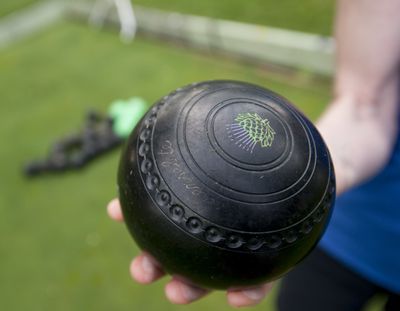Local lawn bowlers enjoy camaraderie, competition

“Boys, don’t bowl on the green. The green is for the king, the king is for the queen …”
This evening as we approach the bowling green, three peregrine falcons stop their dance on the putting green-like surface and eye us suspiciously before flying to the top rail of the enclosure’s cyclone fence. They join a fourth falcon in the green cover of a large, leafy tree, and we unlock the gate to Spokane’s only remaining lawn bowling green.
It has been a sweaty afternoon; the temperature still hangs in the high 90s. We have learned to anticipate the calm coolness offered by the reclusive grassy rectangle tucked into this tree-shaded section behind Mission Park’s Witter Aquatic Center. Railroad tracks border on the west side, and the Spokane River angles on the east.
In 10 minutes, tonight’s bowlers will drive down the path leading from the west end of the swimming pool’s parking lot, uncurl from their air-conditioned cars, and approach the clubhouse to gather their equipment. The night’s conversation will include asking Julenne about her family reunion, guessing from Rich Gaffey’s stride how many soccer games he refereed today, and gauging how Candee Compogno’s orthopedic recovery is proceeding.
We unlock the door to the century-old Italian Renaissance bathhouse and descend into the Spokane Lawn Bowling Association’s clubhouse. This wall is filled with photos of SLBA’s presidents since the club’s 1976 founding (the atmosphere belies the club’s mere 38 years), though I recall a photo on the back wall includes nine men in bowler hats and white shirts on Manito Park’s former bowling green, dated 1913. There are several old trophies won at tournaments in Canadian bowling strongholds like Vernon, Kelowna and Penticton.
Along the lower counters are piles of mini-booklets, one with the typeset green title “The ‘HOW’ of Lawn Bowling and Terms Thereof.” Eleven small pages end with the reminder that “all bowlers are to shake hands with each member of the opposing team. Winners should always be gracious to the losers – and the losers should be sports and just as gracious to the winners.”
During our three years of seasonal evening bowling here, my husband and I have found the competition instructive, friendly and encouraging, with each bowler intent on his own best shots. The club is open to anyone in Spokane. Members manage “our green and clubhouse” personally: Two members alternate mowing duties before our twice-a-week bowling days (spending our modest dues on gas and blade sharpening), ensuring a well-striped green for the evening’s match. Rich Gaffey, a local teacher and soccer referee who has been a member for more than 20 years, dedicates his nightly Centennial Trail bike ride to clicking on the sprinklers.
Back inside, we move to the cubbyholes and each gather our box of four bowls for the evening’s game. My husband chooses the midsize black bowls adorned on either side with Scottish thistles, an historical bow to the game’s regal roots. I “borrow” Loretta’s bowls, identified with family crests on either side. Many cubbies contain dusty bowl cases, untouched in our three years of association with the club, and a few even hold shoes and straw hats awaiting their owners.
When Sam pops into the clubhouse, we move toward the green where we choose a “rink” or lane that runs the 120 regulation feet to the other end. Steve’s team wins the roll, so he uses an underhand toss of the small white jack ball toward the opposite end. All bowlers in our rink now know their target. The game commences with alternating bowlers using this same underhanded release, trying to place their lop-sided, softball-size bowls closest to the jack while avoiding (or blasting) the other resting bowls. Sam is especially smooth in his genuflecting delivery, and is able to finesse his one-side-less-rounded (biased) bowl around two others protecting the jack ball, smacking the jack 3 feet deeper in the rink. All the earlier near bowls are now obsolete. The “end” finishes with a “3” chalked on the pocked scoreboard for Sam’s team, and his opponents hoping for more luck during the ensuing 13 ends.
Right around the time we are bowling from the seventh end, on schedule, the BNSF Railway engine chugs along the green-side tracks. The engineer, needing to blow the horn as he approaches the nearby Mission Avenue railroad crossing in front of Avista’s headquarters, checks to see if any of us is in a mid-bowl stance. Only after the bowl is released, the engineer toots his horn, and we turn to meet his wave. I breathe in deeply and appreciate my fortune – what a relaxing way to pass two hours outdoors on a perfect summer’s eve.
Candee Compogno, club president, and husband Sam, a Spokane School District P.E. specialist, have been bowling most Tuesday and Friday evenings, from mid-May through September, for 14 years. Sam explains lawn bowling as “a game of fractions, or inches. You never know who will win until the last bowl stops.”
Candee likes that the game is “something we can play together as a couple,” with a woman equally capable of having a perfect night. Rich offers one word: “Relaxing.”
Fourteen ends take almost two hours tonight; the scoreboard shows Steve’s (and Sam’s) team: 16, Tim’s team 12. We shake hands all around.
Each of us gathers a piece of equipment and our bowls, stopping to swipe a cookie from Julenne’s generous plate, and in five minutes the green is darkened, the goodbyes are quieting, and the sprinklers are whispering. Likely the falcons are breathing a sigh of relief.